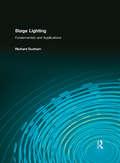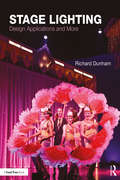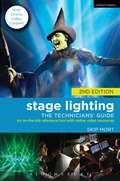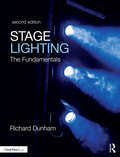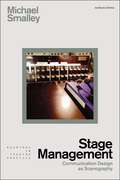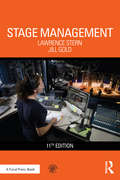- Table View
- List View
Stage Lighting: Fundamentals and Applications
by Richard E. DunhamThe book’s organization follows a layered approach that builds on basic principles: Light as a Medium (Part 1), Tools of a Lighting Designer (Part 2), Design Fundamentals (Part 3), and Lighting Applications (Part 4). This presents students with a practical and logical sequence when learning basic concepts. The full spectrum of the lighting design process is presented in detail, giving students an example of how one might develop a lighting design from script analysis through concept and plot development, and all the way to an opening. This detailed process with a step-by-step design approach gives students a plan to work from, which they can later modify as they mature and gain confidence as designers. The text contains a more comprehensive discussion of basic technology, light as a physical phenomena, and methodology of designs than is found in most introductory texts, bridging the gap between introductory and advanced lighting courses. The text will appeal to theatrical designers who want to venture into areas of lighting like architectural or virtual lighting design, while at the same time gaining a solid grounding in the fundmentals of lighting design. Lighting Design will also benefit illuminating engineers who want to move away from mere computational approaches in lighting and on to explore techniques along the design approaches of theatrical lighting design. The final 9 chapters cover many specialty areas of lighting design, highlighting the unique and shared qualities that exist between the different aspects of these elements. Discussions involve traditional entertainment areas like theatre, as well as lesser known facets of the industry including film/video, landscape lighting, retail/museum lighting, virtual lighting, concert, spectacle performances, and architectural lighting. Models of design tasks demonstrate the actual use and development of plots/sections, schedules, photometrics tables, and cut sheets, rather than simply talking about what they are. This hands-on approach provides students with a firm understanding of how to actually use these tools and processes.
Stage Lighting: Fundamentals and Applications
by Richard E. DunhamThe book’s organization follows a layered approach that builds on basic principles: Light as a Medium (Part 1), Tools of a Lighting Designer (Part 2), Design Fundamentals (Part 3), and Lighting Applications (Part 4). This presents students with a practical and logical sequence when learning basic concepts. The full spectrum of the lighting design process is presented in detail, giving students an example of how one might develop a lighting design from script analysis through concept and plot development, and all the way to an opening. This detailed process with a step-by-step design approach gives students a plan to work from, which they can later modify as they mature and gain confidence as designers. The text contains a more comprehensive discussion of basic technology, light as a physical phenomena, and methodology of designs than is found in most introductory texts, bridging the gap between introductory and advanced lighting courses. The text will appeal to theatrical designers who want to venture into areas of lighting like architectural or virtual lighting design, while at the same time gaining a solid grounding in the fundmentals of lighting design. Lighting Design will also benefit illuminating engineers who want to move away from mere computational approaches in lighting and on to explore techniques along the design approaches of theatrical lighting design. The final 9 chapters cover many specialty areas of lighting design, highlighting the unique and shared qualities that exist between the different aspects of these elements. Discussions involve traditional entertainment areas like theatre, as well as lesser known facets of the industry including film/video, landscape lighting, retail/museum lighting, virtual lighting, concert, spectacle performances, and architectural lighting. Models of design tasks demonstrate the actual use and development of plots/sections, schedules, photometrics tables, and cut sheets, rather than simply talking about what they are. This hands-on approach provides students with a firm understanding of how to actually use these tools and processes.
Stage Lighting: Design Applications and More
by Richard E DunhamStage Lighting: Design Applications and More builds upon the information introduced in Stage Lighting: The Fundamentals to provide an in-depth reference to a number of specialty areas of lighting design, from traditional applications such as drama, dance, and designing for different venues, to more advanced applications such as concert, corporate, film and video, virtual, architectural/landscape, and other forms of entertainment lighting. Each chapter gives the essential background, design practices, and equipment details for each specialization, so readers can make informed decisions and ask informed questions when encountering each field. The book provides insight on the latest technology and includes profiles of prolific designers, such as James Moody, Jeff Ravitz, Alan Adelman, and Paul Gregory. Stage Lighting: Design Applications and More is intended to help lighting designers translate their theatrical skills to other areas of lighting design, and provides guidance on how to take those initial steps into new ventures in their lighting careers.
Stage Lighting: Design Applications and More
by Richard E DunhamStage Lighting: Design Applications and More builds upon the information introduced in Stage Lighting: The Fundamentals to provide an in-depth reference to a number of specialty areas of lighting design, from traditional applications such as drama, dance, and designing for different venues, to more advanced applications such as concert, corporate, film and video, virtual, architectural/landscape, and other forms of entertainment lighting. Each chapter gives the essential background, design practices, and equipment details for each specialization, so readers can make informed decisions and ask informed questions when encountering each field. The book provides insight on the latest technology and includes profiles of prolific designers, such as James Moody, Jeff Ravitz, Alan Adelman, and Paul Gregory. Stage Lighting: Design Applications and More is intended to help lighting designers translate their theatrical skills to other areas of lighting design, and provides guidance on how to take those initial steps into new ventures in their lighting careers.
Stage Lighting: An On-the-job Reference Tool with Online Video Resources - 2nd Edition
by Skip MortThis practical guide covers all aspects of stage lighting equipment, special effects, lighting a performance space and lighting design. It is well illustrated with examples of equipment, diagrams, plans and technical data. It also features the work of current lighting designers. The associated video content shows the practical use of equipment and different lighting techniques and effects. It provides easy access to the content through the use of tabulated sections and keyword headings. The information in each chapter is presented at three levels which run visually throughout the guide enabling students to mix and match their own personal level of study or for practitioners to fast track through to the information they need on stage.This new and revised second edition brings the guide right up to date, and includes all new material on the development of LED lighting in recent years, as well as online video resources.
Stage Lighting: An On-the-job Reference Tool with Online Video Resources - 2nd Edition (Performance Bks.)
by Skip MortThis practical guide covers all aspects of stage lighting equipment, special effects, lighting a performance space and lighting design. It is well illustrated with examples of equipment, diagrams, plans and technical data. It also features the work of current lighting designers. The associated video content shows the practical use of equipment and different lighting techniques and effects. It provides easy access to the content through the use of tabulated sections and keyword headings. The information in each chapter is presented at three levels which run visually throughout the guide enabling students to mix and match their own personal level of study or for practitioners to fast track through to the information they need on stage.This new and revised second edition brings the guide right up to date, and includes all new material on the development of LED lighting in recent years, as well as online video resources.
Stage Lighting Second Edition: The Fundamentals
by Richard E. DunhamStage Lighting: The Fundamentals is written specifically for introductory stage lighting courses. The book begins with an examination of the nature of light, perception, and color, then leads into a conversation of stage lighting equipment and technicians. Lamps, luminaries, controls/dimming, and electricity form the basis of these chapters. The book also provides a detailed explanation and overview of the lighting design process for the theatre and several other traditional forms of entertainment. Finally, the book explores a variety of additional areas where lighting designers can find related future employment, such as concert and corporate lighting, themed design, architectural and landscape lighting, and computer animation. New for this edition: enlarged full-color illustrations, photographs, light plots and examples of lighting design;updated information on LED lighting and equipment;expanded discussion of the practical use of color as a designer;expanded discussion of psychological/perceptual effects of color;new discussion of color mixing through light sources that make use of additive mixing;expanded discussion of industry professions;expanded discussion and illustrations relating to photometrics; expanded discussion and examples of control protocols and new equipment; andupdated designer profiles along with the addition of still more designer profiles.
Stage Lighting Second Edition: The Fundamentals
by Richard E. DunhamStage Lighting: The Fundamentals is written specifically for introductory stage lighting courses. The book begins with an examination of the nature of light, perception, and color, then leads into a conversation of stage lighting equipment and technicians. Lamps, luminaries, controls/dimming, and electricity form the basis of these chapters. The book also provides a detailed explanation and overview of the lighting design process for the theatre and several other traditional forms of entertainment. Finally, the book explores a variety of additional areas where lighting designers can find related future employment, such as concert and corporate lighting, themed design, architectural and landscape lighting, and computer animation. New for this edition: enlarged full-color illustrations, photographs, light plots and examples of lighting design;updated information on LED lighting and equipment;expanded discussion of the practical use of color as a designer;expanded discussion of psychological/perceptual effects of color;new discussion of color mixing through light sources that make use of additive mixing;expanded discussion of industry professions;expanded discussion and illustrations relating to photometrics; expanded discussion and examples of control protocols and new equipment; andupdated designer profiles along with the addition of still more designer profiles.
Stage Lighting - the technicians guide: An on-the-job reference tool (Performance Books)
by Skip Mort"Stage technicians or 'techies' don't read books, they seek information on the basis of the need to know."This is a practical guide to stage lighting covering equipment, lighting a performance space, special effects and lighting design. It can be read cover-to-cover, but also used as reference manual which provides easy access to the content through the use of tabulated sections and keywords. The information in each chapter is presented at three levels: - A quick start - basic information providing enough to get started- More info - more detailed knowledge- Extras! - extended technical information and data The three strands run visually throughout the guide enabling students to mix and match their own personal level of study or to fast track through to the information they need on stage. This handy, accessible guide is packed with illustrations, pictures, diagrams, plans and technical data. In addition a DVD is included using unique video clips to illustrate the text, show the practical use of equipment, and examples of different lighting techniques and effects. The differentiated format makes it equally suitable as a quick start for school students or at an extended level for aspiring theatre technicians, teachers, amateur dramatic enthusiasts or anyone needing a quick on-the-job reference.
Stage Lighting - the technicians guide: An on-the-job reference tool (Performance Books)
by Skip Mort"Stage technicians or 'techies' don't read books, they seek information on the basis of the need to know."This is a practical guide to stage lighting covering equipment, lighting a performance space, special effects and lighting design. It can be read cover-to-cover, but also used as reference manual which provides easy access to the content through the use of tabulated sections and keywords. The information in each chapter is presented at three levels: - A quick start - basic information providing enough to get started- More info - more detailed knowledge- Extras! - extended technical information and data The three strands run visually throughout the guide enabling students to mix and match their own personal level of study or to fast track through to the information they need on stage. This handy, accessible guide is packed with illustrations, pictures, diagrams, plans and technical data. In addition a DVD is included using unique video clips to illustrate the text, show the practical use of equipment, and examples of different lighting techniques and effects. The differentiated format makes it equally suitable as a quick start for school students or at an extended level for aspiring theatre technicians, teachers, amateur dramatic enthusiasts or anyone needing a quick on-the-job reference.
Stage Makeup
by Richard Corson James Glavan Beverly Gore NorcrossWidely referred to as the “bible of stage makeup,” the timely revision of this classic text addresses principles and techniques in the use of makeup for the contemporary performer. This extensive exploration of the application and use of stage makeup and makeup for a variety of performance venues covers all aspects in detail and contains over 400 photographs, drawings, and diagrams demonstrating step-by-step procedures. Thoroughly updated and revised, this classic text remains accurate and comprehensive, providing information from which all readers – whether students to the field or seasoned, professional makeup artists – will benefit. New to this edition: Updated photography throughout. Features the latest information on products and techniques throughout. New additions to chapters concerning hairpieces and wigs: making a pattern for a beard and mustache, making a pattern for a wig, fronting a wig, or sending accurate information for rentals, and the basic roller set for wigs. The source Appendix has been totally updated with new vendors and the latest website addresses. The materials Appendix has had the most current products added. There are new, blank makeup charts for class work and designing makeups. There is a color guide for a two-part silicone life cast. The new color section featuring Academy Award nominee, Christien Tinsley, steps for the Tinsley Transfers for cuts, bruises and prosthetics. (As seen in the movie The Passion Of The Christ.) A selection of makeup in color with complete instructions. Color photos of Academy Award winner, Matthew Mungle, special effects makeup for the CSI television show. Instructions for a new “creating a likeness” of Queen Elizabeth I. The Film and Television chapter now includes information about working with the latest HD digital technology. The color section now includes a series of photos illustrating the effects of gel colors on natural makeup.
Stage Makeup
by Richard Corson James Glavan Beverly Gore NorcrossWidely referred to as the “bible of stage makeup,” the timely revision of this classic text addresses principles and techniques in the use of makeup for the contemporary performer. This extensive exploration of the application and use of stage makeup and makeup for a variety of performance venues covers all aspects in detail and contains over 400 photographs, drawings, and diagrams demonstrating step-by-step procedures. Thoroughly updated and revised, this classic text remains accurate and comprehensive, providing information from which all readers – whether students to the field or seasoned, professional makeup artists – will benefit. New to this edition: Updated photography throughout. Features the latest information on products and techniques throughout. New additions to chapters concerning hairpieces and wigs: making a pattern for a beard and mustache, making a pattern for a wig, fronting a wig, or sending accurate information for rentals, and the basic roller set for wigs. The source Appendix has been totally updated with new vendors and the latest website addresses. The materials Appendix has had the most current products added. There are new, blank makeup charts for class work and designing makeups. There is a color guide for a two-part silicone life cast. The new color section featuring Academy Award nominee, Christien Tinsley, steps for the Tinsley Transfers for cuts, bruises and prosthetics. (As seen in the movie The Passion Of The Christ.) A selection of makeup in color with complete instructions. Color photos of Academy Award winner, Matthew Mungle, special effects makeup for the CSI television show. Instructions for a new “creating a likeness” of Queen Elizabeth I. The Film and Television chapter now includes information about working with the latest HD digital technology. The color section now includes a series of photos illustrating the effects of gel colors on natural makeup.
Stage Makeup
by Richard Corson James Glavan Beverly Gore NorcrossWidely referred to as the "bible of stage makeup," the timely revision of this classic text addresses principles and techniques in the use of makeup for the contemporary performer. This extensive exploration of the application and use of stage makeup and makeup for a variety of performance venues covers all aspects in detail and contains over 1000 photographs, drawings, and diagrams demonstrating step-by-step procedures. Thoroughly updated and revised, this classic text remains accurate and comprehensive, providing information from which all readers – whether students new to the field or seasoned, professional makeup artists – will benefit. New to this edition: Updated full-color photography throughout Expanded information on makeup design and application 48 new step-by-step instructions in color Expanded chapter on modeling with highlights and shadows New chapter on cross-gender makeup New instruction on making dentures, noses, and face casting New instructions for creating zombies, animals, aging effects, and trauma Expanded information on makeup for television and film Up-to-date information on Special Effects makeup Up-to-date information on prosthetic makeup Updated chapters on facial hair and wigs Updated resources for products, advanced training, and health and safety
Stage Makeup: Special Edition
by Richard Corson James Glavan Beverly Gore NorcrossWidely referred to as the "bible of stage makeup," the timely revision of this classic text addresses principles and techniques in the use of makeup for the contemporary performer. This extensive exploration of the application and use of stage makeup and makeup for a variety of performance venues covers all aspects in detail and contains over 1000 photographs, drawings, and diagrams demonstrating step-by-step procedures. Thoroughly updated and revised, this classic text remains accurate and comprehensive, providing information from which all readers – whether students new to the field or seasoned, professional makeup artists – will benefit. New to this edition: Updated full-color photography throughout Expanded information on makeup design and application 48 new step-by-step instructions in color Expanded chapter on modeling with highlights and shadows New chapter on cross-gender makeup New instruction on making dentures, noses, and face casting New instructions for creating zombies, animals, aging effects, and trauma Expanded information on makeup for television and film Up-to-date information on Special Effects makeup Up-to-date information on prosthetic makeup Updated chapters on facial hair and wigs Updated resources for products, advanced training, and health and safety
Stage Management: Communication Design as Scenography (Readings in Theatre Practice)
by Michael SmalleyDrawing on interview material from more than 20 leading stage managers from the UK, USA and Australia, this book situates the contemporary practice of stage management within its historical and social contexts.Questioning the notions of the invisible stage manager and a linear production process, it argues for a broader conception of stage management lying at the intersections of administration, management and artistry. This volume places stage management practice within key theories drawn from the diverse fields of performance studies, semiotics, phenomenology, distributed cognition, management and scenography. It champions the creative agency of stage management and details the properties of communication which stage managers manipulate and the objectives they set out to achieve as a guide for decision making. While it considers the different approaches necessitated by productions from different cultures, genres, and so on, it offers a view of stage management which is not bound by these differences.
Stage Management: Communication Design as Scenography (Readings in Theatre Practice)
by Michael SmalleyDrawing on interview material from more than 20 leading stage managers from the UK, USA and Australia, this book situates the contemporary practice of stage management within its historical and social contexts.Questioning the notions of the invisible stage manager and a linear production process, it argues for a broader conception of stage management lying at the intersections of administration, management and artistry. This volume places stage management practice within key theories drawn from the diverse fields of performance studies, semiotics, phenomenology, distributed cognition, management and scenography. It champions the creative agency of stage management and details the properties of communication which stage managers manipulate and the objectives they set out to achieve as a guide for decision making. While it considers the different approaches necessitated by productions from different cultures, genres, and so on, it offers a view of stage management which is not bound by these differences.
Stage Management
by Lawrence Stern Jill GoldStage Management offers readers a practical manual on how to stage manage in all theatre environments. Revered as the authoritative resource for stage management, this text is rich with practical resources, including checklists, diagrams, examples, forms and step-by-step directions. In addition to sharing his own expertise, Stern has gathered practical advice from working stage managers of Broadway, off-Broadway, touring companies, regional, community, and 99-seat Equity waiver theaters. In its 11th edition, the book is now fully in color and updated to include new information on Equity contracts, social media applications in stage management, and working with high school productions.
Stage Management
by Lawrence Stern Jill GoldStage Management offers readers a practical manual on how to stage manage in all theatre environments. Revered as the authoritative resource for stage management, this text is rich with practical resources, including checklists, diagrams, examples, forms and step-by-step directions. In addition to sharing his own expertise, Stern has gathered practical advice from working stage managers of Broadway, off-Broadway, touring companies, regional, community, and 99-seat Equity waiver theaters. In its 11th edition, the book is now fully in color and updated to include new information on Equity contracts, social media applications in stage management, and working with high school productions.
Stage Management
by Lawrence Stern Jill GoldNow in its twelfth edition, Stage Management is the comprehensive go-to manual on stage management in all theatre environments. Revered as the authoritative resource for stage management, this text is rich with practical resources, including checklists, diagrams, examples, forms, and step-by-step directions. In addition to sharing their own expertise, Stern and Gold have gathered practical advice from working stage managers of Broadway, off-Broadway, touring companies, regional, community, and 99-seat Equity waiver theatres. This new edition has been fully updated with new technology and best practices, including: New websites for stage management tools and software Updated Equity rules Additional safety and emergency protocols New voices from practicing stage managers in text boxes and case studies scattered throughout the book. This practical guide is written for students of Stage Management in Theatre programs, as well as early career stage managers. The companion website features paperwork templates, downloadable checklists, suggested readings, a list of websites and apps with today’s cutting-edge stage management technology, and a list of over 500 internships and apprenticeships available across the United States.
Stage Management
by Lawrence Stern Jill GoldNow in its twelfth edition, Stage Management is the comprehensive go-to manual on stage management in all theatre environments. Revered as the authoritative resource for stage management, this text is rich with practical resources, including checklists, diagrams, examples, forms, and step-by-step directions. In addition to sharing their own expertise, Stern and Gold have gathered practical advice from working stage managers of Broadway, off-Broadway, touring companies, regional, community, and 99-seat Equity waiver theatres. This new edition has been fully updated with new technology and best practices, including: New websites for stage management tools and software Updated Equity rules Additional safety and emergency protocols New voices from practicing stage managers in text boxes and case studies scattered throughout the book. This practical guide is written for students of Stage Management in Theatre programs, as well as early career stage managers. The companion website features paperwork templates, downloadable checklists, suggested readings, a list of websites and apps with today’s cutting-edge stage management technology, and a list of over 500 internships and apprenticeships available across the United States.
Stage Management Basics: A Primer for Performing Arts Stage Managers
by Emily Roth Jonathan Allender-Zivic Katy McGlaughlinWithout assuming any intrinsic prior knowledge of the theatrical field and its associated, specialized terminology, Stage Management Basics covers every aspect of the stage management, from reading a script, meeting with a director and theatre staff, and auditioning, to constructing green digital scripts, communication best practices, and opening night protocol. Additionally, this book features multiple appendices containing stage management form templates, blank version of which are available on its companion website. This book touches on basic principles for stage management for theatre, dance, and opera productions.
Stage Management Basics: A Primer for Performing Arts Stage Managers
by Emily Roth Jonathan Allender-Zivic Katy McGlaughlinWithout assuming any intrinsic prior knowledge of the theatrical field and its associated, specialized terminology, Stage Management Basics covers every aspect of the stage management, from reading a script, meeting with a director and theatre staff, and auditioning, to constructing green digital scripts, communication best practices, and opening night protocol. Additionally, this book features multiple appendices containing stage management form templates, blank version of which are available on its companion website. This book touches on basic principles for stage management for theatre, dance, and opera productions.
Stage Management Basics: A Primer for Performing Arts Stage Managers
by Emily Roth Jonathan Allender-Zivic Katy McGlaughlinStage Management Basics, second edition, offers a deep dive into the basics of stage management for theatre, dance, and opera productions. Without assuming any intrinsic prior knowledge of the theatrical field and its associated, specialized terminology, this book covers every aspect of stage management, from reading a script, meeting with a director and theatre staff, and running auditions to communication best practices and opening night protocol. This new edition features brand new chapters on opera, dance, and unions, information on working with intimacy and fight directors, updated tips and tricks, and vibrant color images. Using simple language and detailed explanations, this book is the perfect primer for the beginning stage management student. The companion website contains blank form templates, chapter comprehension tests, a suggested reading list, glossary flashcards, and more.
Stage Management Basics: A Primer for Performing Arts Stage Managers
by Emily Roth Jonathan Allender-Zivic Katy McGlaughlinStage Management Basics, second edition, offers a deep dive into the basics of stage management for theatre, dance, and opera productions. Without assuming any intrinsic prior knowledge of the theatrical field and its associated, specialized terminology, this book covers every aspect of stage management, from reading a script, meeting with a director and theatre staff, and running auditions to communication best practices and opening night protocol. This new edition features brand new chapters on opera, dance, and unions, information on working with intimacy and fight directors, updated tips and tricks, and vibrant color images. Using simple language and detailed explanations, this book is the perfect primer for the beginning stage management student. The companion website contains blank form templates, chapter comprehension tests, a suggested reading list, glossary flashcards, and more.
Stage Management Theory as a Guide to Practice: Cultivating a Creative Approach
by Lisa Porter Narda E. AlcornStage Management Theory as a Guide to Practice offers theory and methodology for developing a unique stage management style, preparing stage managers to develop an adaptive approach for the vast and varied scope of the production process, forge their own path, and respond to the present moment with care and creativity. This book provides tactile adaptive strategies, enabling stage managers to navigate diverse populations, venues, and projects. Experiential stories based on extensive experience with world-renowned artists exemplify the practices and provide frameworks for self-reflection, synthesis, and engagement with theory-guided practice. This book empowers stage managers to include the ‘How You’ with ‘How To’ by flexing collaborative muscles and engaging tools to guide any collaborative project to fruition with creativity, curiosity, and the drive to build connections. Exploring topics such as group dynamics, ethics, culture, conflict resolution, and strategic communication, Stage Management Theory as a Guide to Practice: Cultivating a Creative Approach is an essential tool for advanced stage management students, educators, and professionals.
